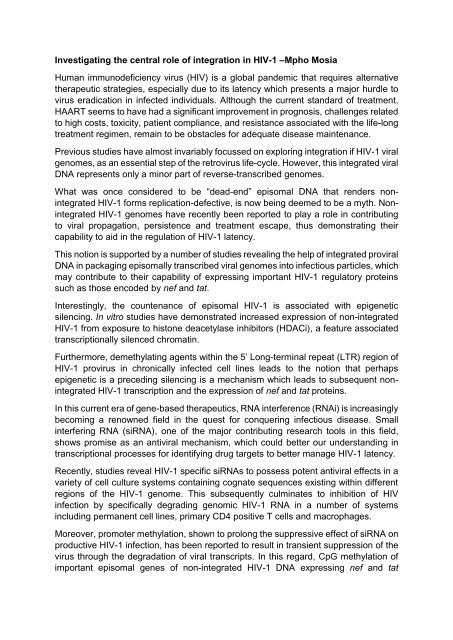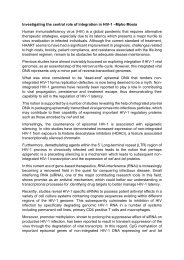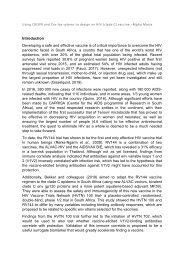RNAi siRNA-induced DNA methylation of HIV-1 LTR
The aim here is to investigate non-integrated HIV-1 genomes by siRNA-induced promoter methylation, specifically in the 5’ Long-terminal repeat region
The aim here is to investigate non-integrated HIV-1 genomes by siRNA-induced promoter methylation, specifically in the 5’ Long-terminal repeat region
You also want an ePaper? Increase the reach of your titles
YUMPU automatically turns print PDFs into web optimized ePapers that Google loves.
Investigating the central role <strong>of</strong> integration in <strong>HIV</strong>-1 –Mpho Mosia<br />
Human immunodeficiency virus (<strong>HIV</strong>) is a global pandemic that requires alternative<br />
therapeutic strategies, especially due to its latency which presents a major hurdle to<br />
virus eradication in infected individuals. Although the current standard <strong>of</strong> treatment,<br />
HAART seems to have had a significant improvement in prognosis, challenges related<br />
to high costs, toxicity, patient compliance, and resistance associated with the life-long<br />
treatment regimen, remain to be obstacles for adequate disease maintenance.<br />
Previous studies have almost invariably focussed on exploring integration if <strong>HIV</strong>-1 viral<br />
genomes, as an essential step <strong>of</strong> the retrovirus life-cycle. However, this integrated viral<br />
<strong>DNA</strong> represents only a minor part <strong>of</strong> reverse-transcribed genomes.<br />
What was once considered to be “dead-end” episomal <strong>DNA</strong> that renders nonintegrated<br />
<strong>HIV</strong>-1 forms replication-defective, is now being deemed to be a myth. Nonintegrated<br />
<strong>HIV</strong>-1 genomes have recently been reported to play a role in contributing<br />
to viral propagation, persistence and treatment escape, thus demonstrating their<br />
capability to aid in the regulation <strong>of</strong> <strong>HIV</strong>-1 latency.<br />
This notion is supported by a number <strong>of</strong> studies revealing the help <strong>of</strong> integrated proviral<br />
<strong>DNA</strong> in packaging episomally transcribed viral genomes into infectious particles, which<br />
may contribute to their capability <strong>of</strong> expressing important <strong>HIV</strong>-1 regulatory proteins<br />
such as those encoded by nef and tat.<br />
Interestingly, the countenance <strong>of</strong> episomal <strong>HIV</strong>-1 is associated with epigenetic<br />
silencing. In vitro studies have demonstrated increased expression <strong>of</strong> non-integrated<br />
<strong>HIV</strong>-1 from exposure to histone deacetylase inhibitors (HDACi), a feature associated<br />
transcriptionally silenced chromatin.<br />
Furthermore, demethylating agents within the 5’ Long-terminal repeat (<strong>LTR</strong>) region <strong>of</strong><br />
<strong>HIV</strong>-1 provirus in chronically infected cell lines leads to the notion that perhaps<br />
epigenetic is a preceding silencing is a mechanism which leads to subsequent nonintegrated<br />
<strong>HIV</strong>-1 transcription and the expression <strong>of</strong> nef and tat proteins.<br />
In this current era <strong>of</strong> gene-based therapeutics, RNA interference (<strong>RNAi</strong>) is increasingly<br />
becoming a renowned field in the quest for conquering infectious disease. Small<br />
interfering RNA (<strong>siRNA</strong>), one <strong>of</strong> the major contributing research tools in this field,<br />
shows promise as an antiviral mechanism, which could better our understanding in<br />
transcriptional processes for identifying drug targets to better manage <strong>HIV</strong>-1 latency.<br />
Recently, studies reveal <strong>HIV</strong>-1 specific <strong>siRNA</strong>s to possess potent antiviral effects in a<br />
variety <strong>of</strong> cell culture systems containing cognate sequences existing within different<br />
regions <strong>of</strong> the <strong>HIV</strong>-1 genome. This subsequently culminates to inhibition <strong>of</strong> <strong>HIV</strong><br />
infection by specifically degrading genomic <strong>HIV</strong>-1 RNA in a number <strong>of</strong> systems<br />
including permanent cell lines, primary CD4 positive T cells and macrophages.<br />
Moreover, promoter <strong>methylation</strong>, shown to prolong the suppressive effect <strong>of</strong> <strong>siRNA</strong> on<br />
productive <strong>HIV</strong>-1 infection, has been reported to result in transient suppression <strong>of</strong> the<br />
virus through the degradation <strong>of</strong> viral transcripts. In this regard, CpG <strong>methylation</strong> <strong>of</strong><br />
important episomal genes <strong>of</strong> non-integrated <strong>HIV</strong>-1 <strong>DNA</strong> expressing nef and tat
proteins seems to be a promising knock-down approach that could lead to the<br />
eradicating <strong>HIV</strong>-1 latency.<br />
In this respect, I aim to investigate non-integrated <strong>HIV</strong>-1 genomes by <strong>siRNA</strong>-<strong>induced</strong><br />
promoter <strong>methylation</strong>, specifically in the 5’ <strong>LTR</strong> <strong>of</strong> this burdensome retroviral disease.





